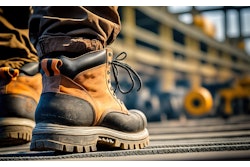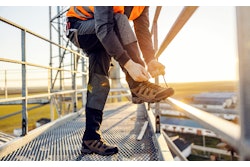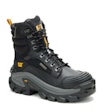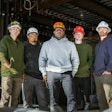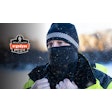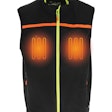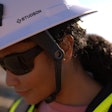
Rubber boots provide a safe and comfortable option for those working on construction sites in wet, cold and muddy conditions. Rubber boots offer significant durability in that they are constructed from high-quality rubber or rubber compounds that are resistant to wear and tear and as such are designed to offer a long lifespan.
Also because of the material of which they are made, rubber boots are flexible and lightweight and as a result, those wearing them tend to feel less foot fatigue as compared to wearing other boot types. The addition of good arch support in rubber boots can reduce fatigue.
Working around chemicals and solvents is another occupational hazard for which rubber boots may be indicated for construction workers, according to the American Podiatric Medical Association.
Toe Protection and Grip
As with the choice of any footwear on a construction jobsite, safety is priority.
Construction site job requirements will determine the type of footwear needed and if the footwear should include such features as composite toe caps, steel toes, puncture-resistant soles, electrical hazard protection, puncture-resistant safety features or slip-resistant outsoles.
Rubber boots designed with toe protection help mitigate impact and compression hazards.
In choosing rubber boots, construction workers should look for those with a good sole for a firm grip on surfaces. Since good traction is needed in work areas with slippery surfaces, anti-skid technology in rubber boots is another key safety component. Boots designed with deep treads or lugs may help prevent slips and falls during a variety of work tasks, such as climbing ladders, for instance.
For use in cold weather, choose rubber boots with high insulation and thermal heat retention features.
Proper Fit
Just as with any other work boot, proper fit ensures comfort and sufficient room for the toes without being too loose and thus compromising safety. Boots may also be designed with cushioned insoles and a comfortable lining that wicks sweat and fights odors for better breathability.
Rubber boots are available in lace-up and pull-up styles and are offered at different heights. Roll-down calves and a kick-off plate on the outsole of some designs made boot removal easier. Because of the materials of which they are constructed, rubber boots also provide warmth.
In choosing the correct rubber boot size and width, keep in mind the type of socks that will be worn when wearing the boots; try the boots on with the socks that will be worn with them before purchasing the boot to determine if they provide a proper fit.
In considering rubber boot ankle support, consider that boots with higher shafts provide greater stability and support while shorter ones can offer more flexibility.
Boot Safety Standards
To determine whether a specific pair of rubber work boots have met safety footwear regulations, look for a safety label that is usually found on the tongue of the footwear or is otherwise indicated, such as from written information by the source from which the boots are purchased. Safety standards are created and enforced by ASTM International and the Occupational Safety and Health Administration (OSHA).
The two ASTM International documents governing safety footwear is ASTM F2413 and ASTM F2412. They outline the protection level that safety features must provide for workers – including the labeling used on work boots – and provide a guideline for researchers and scientists detailing laboratory methods used in safety footwear testing.
For safety footwear, ASTM regulates for impact protection, metatarsal protection, compression protection, electrical hazard protection, static dissipation, puncture resistance, dielectric insulation and chainsaws.
Section 29 of OSHA’s Code of Federal Regulations 1910.136 indicates that ‘The employer shall ensure that each affected employee uses protective footwear when working in areas where there is a danger of foot injuries due to falling or rolling objects, or objects piercing the sole, or when the use of protective footwear will protect the affected employee from an electrical hazard, such as a static-discharge or electric-shock hazard."
A construction site crew’s safety manager or consultant can assess jobsite hazards and determine the appropriate safety footwear required, including features rubber boots should encompass.
Those construction workers who have unique foot considerations should check with a podiatrist to determine if the rubber boots, they choose to wear should include inserts or any modifications as to avoid any potential foot injuries.


